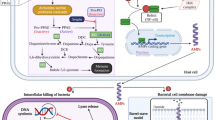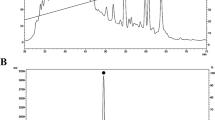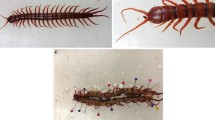Abstract
Maggots of Lucilia sericata are widely used in the therapy of infected wounds and skin ulcers. Antimicrobial materials released by the insects during their feeding period in order to suppress microbial competitors and potential pathogens play the key role both in the maggots’ survival in their natural habitats (animal corpses) and their therapeutic efficacy. Although the antimicrobial activity of the maggots’ excretion was demonstrated about a hundred years ago, little is known about the nature of its active compounds. We studied the structural characteristics and antimicrobial activities of the compounds released by L. sericata maggots into the environment. To isolate the compounds, excretion was collected from the culture of actively feeding last instar larvae, active compounds were purified using a combination of liquid chromatography and antibacterial growth inhibition assay and characterized by mass spectrometry. Two groups of antibacterial compounds were isolated from the excretion: polypeptides with molecular masses ranging from 6466 to 9025 Da and small molecules with molecular masses ranging from 130 to 700 Da. The polypeptides characterized by the masses of 8882 and 9025 Da and showing selective activity against Gram-negative bacteria correspond well to diptericins, antimicrobial peptides previously found in the hemolymph of Calliphoridae maggots and known to be part of immune response to bacterial pathogens. Other high-molecular compounds with masses 6466, 6633, 5772, and 8631 Da have no clear analogs among antimicrobial peptides present in the hemolymph. The nature of small molecules present in the excretion awaits further study. Thus, the diversity of antimicrobial compounds discovered in Lucilia excretion demonstrates a sophisticated strategy that helps the maggots to fight bacteria and other microorganisms settling their environment. The strategy combines secretion of a set of antibacterial peptides involved in insect immune response as well as molecules which function outside the host organism.
Similar content being viewed by others
References
Barinova, K.V., Psurtseva, N.V., and Vlasov, D.Yu., “Fungi as Producers of Antibiotic Compounds,” Trudy Zool. Nauchn.-Issled. Inst. SPbGU, No. 54, 232–243 (2008).
Bexfield, A., Nigam, Y., Thomas, S., and Ratcliffe, N.A., “Detection and Partial Characterization of Two Antibacterial Factors from the Excretions / Secretions of the Medicinal Maggot Lucilia sericata and Their Activity against Methicillin-Resistant Staphylococcus aureus (MRSA),” Microbes and Infection 6, 1297–1304 (2004).
Bexfield A., Bond E., Roberts E.C., et al., “The Antibacterial Activity against MRSA Strains and Other Bacteria of a Less Than 500 Da Fraction from Maggot Excretions / Secretions of Lucilia sericata (Diptera: Calliphoridae),” Microbes and Infection 10, 325–333 (2008).
Bulet, P., Hetru, C., Dimarcq, J.L., and Hoffmann, D., “Antimicrobial Peptides in Insects: Structure and Function,” Devel. Comp. Immunol. 23, 329–344 (1999).
Cazander, G., Van Veen, K.E.B., Bernards, A.T., and Jukema, G.N., “Do Maggots Have an Influence on Bacterial Growth? A Study on the Susceptibility of Strains of Six Different Bacterial Species to Maggots of Lucilia sericata and Their Excretions / Secretions,” J. Tissue Viability 18(3), 80–87 (2009).
Chernysh, S.I., Gordja, N.A., and Simonenko, N.P., “Diapause and Immune Response: Induction of Antimicrobial Peptide Synthesis in the Blowfly, Calliphora vicina R.-D. (Diptera, Calliphoridae),” Entomol. Sci. 3(1), 139–144 (2000).
Chernysh, S.I., Gordja, N.A., Nesin, A.P., et al., “The Immune System of Insects as a Source of New Medicines,” Trudy Zool. Nauchn.-Issled. Inst. SPbGU, No. 54, 119–126 (2008).
Chicz, R.M. and Regnier, F.E., “High-Performance Liquid Chromatography: Effective Protein Purification by Various Chromatographic Modes,” J. Methods Enzymol. 182, 392–421 (1990).
Constable, S.A., “A Comparison of Proteases Produced by Larvae of Lucilia cuprina (Wiedemann), L. sericata (Meigen), Calliphora augur (F.) and C. stygia (F.) (Diptera: Calliphoridae),” J. Aust. Ent. Soc. 33, 203–210 (1994).
Gross, J.H., Mass Spectrometry: a Textbook (Springer, Heidelberg, 2004).
Hoffmann, J.A., “Innate Immunity of Insects,” Current Opinion Immunol. 7, 4–10 (1995).
Huberman, L., Gollop, N., Breuer, E., et al., “Antibacterial Substances of Low Molecular Weight Isolated from the Blowfly, Lucilia sericata,” Med. Vet. Entomol. 21, 127–131 (2007).
Jaklic, D., Lapanje, A., Zupancic, K., et al., “Selective Antimicrobial Activity of Maggots against Pathogenic Bacteria,” J. Med. Microbiol. 57, 617–625 (2008).
Kerridge, A., Lappin-Scott, H., and Stevens, J.R., “Antibacterial Properties of Larval Secretions of the Blowfly, Lucilia sericata,” Med. Vet. Entomol. 19, 333–337 (2005).
Medvedev, S.S., Plant Physiology (St. Petersburg, 2004) [in Russian].
Meylaers, K., Cerstiaens, A., Vierstraete, E., et al., “Antimicrobial Compounds of Low Molecular Mass are Constitutively Present in Insects: Characterization of β-Alanyl-Tyrosine,” Current Pharmaceut. Design 9, 159–174 (2003).
Mumcuoglu, K., Miller, J., Mumcuoglu, M., et al., “Destruction of Bacteria in the Digestive Tract of the Maggot of Lucilia sericata (Diptera: Calliphoridae),” J. Med. Entomol. 38, 161–166 (2001).
Nigam, Y., Bexfield, A., Thomas, S., and Ratcliffe, N.A., “Maggot Therapy: the Science and Implication for CAM. Part I — History and Bacterial Resistance,” Evid. Based Complement. Alternat. Med. 3(2), 223–227 (2006a).
Nigam, Y., Bexfield, A., Thomas, S., and Ratcliffe, N.A., “Maggot Therapy: the Science and Implication for CAM. Part II — Maggots Combat Infection,” Evid. Based Complement. Alternat. Med. 3(3), 303–308 (2006b).
Selsted, M.E., Miller, S.I., Henschen, A.H., and Ouellettell, A.J., “Enteric Defensins: Antibiotic Peptide Components of Intestinal Host Defense,” J. Cell Biol. 118(4), 929–936 (1992).
Sherman, R.A., “Maggot Therapy for Treating Diabetic Foot Ulcers Unresponsive to Conventional Therapy,” Diabetes Care 26(2), 446–451 (2003).
Thomas, S., Andrews, A., Hay, P., and Bourgoise, S., “The Anti-Microbial Activity of Maggot Secretions: Results of a Preliminary Study,” J. Tissue Viability 9, 127–132 (1999).
Trenszec, T. and Faye, I., “Synthesis of Immune Proteins in Primary Cultures of Fat Body from Hyalophora cecropia,” J. Insect Biochem. 18, 299–312 (1988).
Tzou, P., Ohresser, S., Ferrandon, D., et al., “Tissue-Specific Inducible Expression of Antimicrobial Peptide Genes in Drosophila Surface Epithelia,” Immunity 13, 737–748 (2000).
Van der Plas, M.J.A., Van der Does, A.M., Baldry, M., et al., “Maggot Excretions / Secretions Inhibit Multiple Neutrophil Pro-Inflammatory Responses,” Microbes and Infection 9, 507–514 (2007).
Vinogradova, E.B., “The Blowfly Calliphora vicina as a Model Object of Physiological and Ecological Studies,” Trudy Zool. Inst. Akad. Nauk SSSR 118, 1–272 (1984).
Weinbergl, A., Krisanaprakornkit, S., and Dale, B.A., “Epithelial Antimicrobial Peptides: Review and Significance for Oral Application,” Crit. Rev. Oral Biol. Med. 9(4), 399–414 (1998).
Whitaker, I.S., Twine, C., Whitaker, M.J., et al., “Larval Therapy from Antiquity to Present Day: Mechanisms of Action, Clinical Application and Future Potential,” Postgrad. Med. J. 83, 409–413 (2007).
Author information
Authors and Affiliations
Additional information
Original Russian Text © A.A. Kruglikova, S.I. Chernysh, 2011, published in Entomologicheskoe Obozrenie, 2011, Vol. 90, No. 3, pp. 504–513.
Rights and permissions
About this article
Cite this article
Kruglikova, A.A., Chernysh, S.I. Antimicrobial compounds from the excretions of surgical maggots, Lucilia sericata (Meigen) (Diptera, Calliphoridae). Entmol. Rev. 91, 813–819 (2011). https://doi.org/10.1134/S0013873811070013
Received:
Published:
Issue Date:
DOI: https://doi.org/10.1134/S0013873811070013




